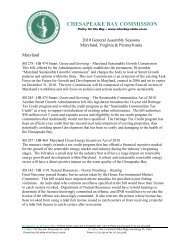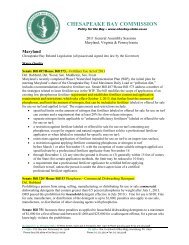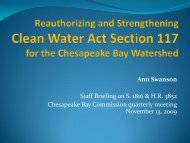Seizing Opportunities and Removing Obstacles
Seizing Opportunities and Removing Obstacles
Seizing Opportunities and Removing Obstacles
Create successful ePaper yourself
Turn your PDF publications into a flip-book with our unique Google optimized e-Paper software.
<strong>Seizing</strong> <strong>Opportunities</strong> <strong>and</strong> <strong>Removing</strong> <strong>Obstacles</strong>
Mid-Atlantic region has a small percentage of low/medium levels of P.<br />
% of Soils with High/very high P levels: MD = 78% (<strong>and</strong> increasing based<br />
on 2001-2005 data), DE = 82%, PA = 64%, VA = 66%<br />
(Better Crops/Vol.86 (2002, No. 1), P.E. Fixen)<br />
3
USDA 2002 Report<br />
Lancaster region, PA<br />
Eastern shore, MD/VA/DE<br />
Shen<strong>and</strong>oah Valley, VA<br />
Excess Manure P assuming no export of manure from county, 1997<br />
Chesapeake Bay Watershed is one of the regions nationwide with the highest excess<br />
manure P (greater than 2 million lbs/county).<br />
4
Manure P supply: Cropl<strong>and</strong> P dem<strong>and</strong><br />
Confined Animal Production <strong>and</strong> Manure Nutrients.<br />
N. Gollehon, M. Caswell, M. Ribaudo, R. Kellogg, C. L<strong>and</strong>er, <strong>and</strong> D. Letson.<br />
Agriculture Information Bulletin No. (AIB771) 40 pp, June 2001. USDA-ERS.
Finding the<br />
“Win - Win”<br />
Technologies exist to<br />
produce energy from<br />
manure that provide<br />
the farmer with<br />
income <strong>and</strong> reduce air<br />
<strong>and</strong> water pollution.<br />
How can we get more<br />
projects “on the<br />
ground” in the Bay<br />
watershed?<br />
Agricultural<br />
Sustainability
What changes are needed at the federal <strong>and</strong><br />
state level to encourage successful deployment<br />
of manure-to-energy technologies at the<br />
regional, community <strong>and</strong> farm scale?<br />
• Market Entry Factors<br />
• Financing for Maximizing Benefits<br />
• Markets for Byproducts
3 ways to help<br />
Getting more<br />
projects on the<br />
ground will<br />
require multiple<br />
solutions. Help us<br />
to underst<strong>and</strong><br />
what policies are<br />
needed <strong>and</strong> the<br />
order of priority.<br />
• Clarify <strong>and</strong> add to<br />
what the policy analysts<br />
have presented<br />
• Vote for your top 3<br />
priorities for the next 1-<br />
2 years.<br />
• Complete the Survey
OPPORTUNITY- Use RPS to get higher price for manure to energy<br />
Renewable Portfolio St<strong>and</strong>ard<br />
Md.- 20% by 2022; 2% solar<br />
Pa.- 18% by 2021; .44% solar<br />
Va.- 12% by 2024 (voluntary)<br />
ISSUES<br />
• Utilities buy renewable energy credits (REC’s) from 12<br />
states <strong>and</strong> D.C. in PJM, our regional transmission<br />
organization.<br />
• Will not necessarily promote in-state production.<br />
• REC market is flooded, can be banked for two years.
Extend RPS solar incentives to Manure to Energy<br />
1. Adopt Technology Specific Set Asides for Manure to<br />
Energy.<br />
2. Increase Alternative Compliance Payments for Manure<br />
to Energy.<br />
3. Adopt Credit Multipliers for Manure to Energy.<br />
4. VA adopt a m<strong>and</strong>atory RPS.<br />
5. Couple with state tax <strong>and</strong> funding incentives for in state<br />
production.
OPPORTUNITY<br />
Offset power otherwise bought from grid.<br />
ISSUE<br />
• Need to aggregate meters to offset costs for all farm<br />
structures.<br />
• Contracts with Poultry Growers may include propane so<br />
power produced would not be used to offset<br />
heating/cooling costs.<br />
RECOMMENDATION<br />
1. Virginia allow aggregation of meters.<br />
2. Industry remove unintentional barriers to grower power<br />
generation.<br />
I
OPPORTUNITY<br />
Sell “green energy” to utilities <strong>and</strong> the grid
Small Projects: (Net metered); MD- 2MW<br />
Residential, PA- 50kW; VA-20kW;<br />
Commercial, PA- 3MW; VA- 500kW<br />
Grants + Tax Credits + Avoided Costs + Tipping fees+ Sell excess<br />
electric to utility= Payback period 3-5 years<br />
Medium <strong>and</strong> Large Projects: (Utility or Wholesale)<br />
MD > 2 MW; PA>5MW; VA> 500KW<br />
Grants + Tax Credits + Possible Avoided Costs (contract with large<br />
energy user like prison, industrial, park, processing plant) +Sell to<br />
utility <strong>and</strong> on wholesale market.
ISSUE- Power Purchase Agreements<br />
Medium <strong>and</strong> Large scale projects need long term power<br />
purchase agreements <strong>and</strong> above market rates to attract<br />
investment.
¢/kwh<br />
Long-Term Power Purchase Agreements<br />
Market Price<br />
Contract Price<br />
time
1. Investor owned utilities enter into long term power<br />
purchase agreements for manure to energy. Surcharge<br />
on utility bills to support PPA’s.<br />
2. States purchase manure to energy power for state<br />
needs.<br />
A
• “Bay Power” certification for market based br<strong>and</strong>ing<br />
• States certify that Bay Power:<br />
• Is generated from manure to energy.<br />
• Has added water quality components.<br />
• Is generated in-state or in watershed, or<br />
• Is generated in watershed manure hotspots<br />
R,<br />
L<br />
• Create “premium” br<strong>and</strong>.<br />
• Utilities <strong>and</strong> alternate electric suppliers market.<br />
• Capitalize on movements to buy local, support<br />
clean energy, Save the Bay.
The rate of actual productivity in a year<br />
compared to the theoretical maximum<br />
24hrs/day ; 7 days/week; 365 days/year
U.S. Capacity Factors by Fuel Type<br />
2010<br />
Fuel Type<br />
Average Capacity Factors<br />
(%)<br />
Nuclear 91.2<br />
Biomass 85.5<br />
Geothermal 71.6<br />
Coal (Steam Turbine) 65.4<br />
Gas (Combined Cycle) 45.8<br />
Hydro 29.4<br />
Wind 29.1<br />
Solar 17.7<br />
Gas (Steam Turbine) 12.9<br />
Oil Source: (Steam Ventyx Velocity Turbine) Suite / Energy Information Administration<br />
8.9<br />
Updated: 4/11
Funding Sources<br />
• Different sources for different phases of<br />
technology development <strong>and</strong> scale<br />
• Federal – focus on Farm Bill programs<br />
• State – emphasis on tweaks to<br />
existing programs
OPPORTUNITY<br />
State <strong>and</strong> federal grant <strong>and</strong> loan programs that can be<br />
used for alternative energy projects.<br />
ISSUE<br />
Funds are not widely used for manure to energy projects<br />
or, if they are, no explicit link to water quality benefits.<br />
RECOMMENDATION<br />
Give priority to manure to energy projects that address<br />
water quality issues. Devote resources to technical<br />
assistance <strong>and</strong> outreach.<br />
A, L
Example<br />
• USDA’s Rural Energy for America Program<br />
(REAP) provides grants <strong>and</strong> loans for alternative<br />
energy projects (e.g., anaerobic digesters).<br />
• Funds from USDA’s Environmental Quality<br />
Incentives Program (EQIP) could be used to fund<br />
an “integrated approach” that also provides<br />
water quality benefits (e.g., separation<br />
technology).<br />
• Alter the scoring system for REAP <strong>and</strong> EQIP to<br />
give priority to integrated projects.
Alternative Energy Grants<br />
<strong>and</strong> Loans FY11<br />
$200,000,000<br />
$180,000,000<br />
$160,000,000<br />
$140,000,000<br />
$120,000,000<br />
Alternative <strong>and</strong> Clean Energy Program<br />
Sustainable Energy Funds<br />
PA Energy Development Authority<br />
$100,000,000<br />
$80,000,000<br />
$60,000,000<br />
$40,000,000<br />
$20,000,000<br />
$0<br />
Strategic Energy Investment Fund<br />
MARBIDCO<br />
Maryl<strong>and</strong> Virginia Pennsylvania
OPPORTUNITY<br />
Refundable or transferable alternative energy state<br />
tax credit programs.<br />
ISSUE<br />
Status of these programs varies across the three<br />
states.<br />
RECOMMENDATION<br />
Revise alternative energy tax credit programs to<br />
provide greater incentives for manure to energy<br />
projects.<br />
L
Comparison of Alternative<br />
Energy Tax Credit Programs<br />
State Legislation Amount Transferable/<br />
Refundable?<br />
Status<br />
Pennsylvania H.B. 1 - 2008 15% of cost of<br />
project<br />
Transferable<br />
No<br />
appropriated<br />
funds<br />
Maryl<strong>and</strong> H.B. 494 - 2010 0.85 cents/kwh Refundable Active<br />
Virginia S.B. 678 - 2011 1.1 cents/kwh Can be carried<br />
over<br />
Legislation<br />
didn’t pass<br />
North Carolina<br />
35% of cost of<br />
project<br />
Can be carried<br />
over<br />
Active
OPPORTUNITY<br />
Sale of nutrient credits as a revenue stream for manure to<br />
energy projects.<br />
ISSUES<br />
1. Dem<strong>and</strong> for nutrient credits is currently low.<br />
2. Manure to energy projects don’t fit well into existing<br />
credit certification approaches.<br />
RECOMMENDATION<br />
1. Stimulate market by establishing credit bank.<br />
2. Establish regional technical review panel to assist in<br />
calculating nutrient credit benefits.<br />
A,L<br />
A
OPPORTUNITY<br />
Sale of separated solids as bedding<br />
ISSUE<br />
Tracking of nutrient fraction that remains in the solids<br />
RECOMMENDATION<br />
Potential revisions of nutrient management requirements<br />
<strong>and</strong> tracking for importers.<br />
A, R
OPPORTUNITY<br />
Sale of separated solids as peat replacement<br />
ISSUE<br />
Economies of scale<br />
Siting<br />
RECOMMENDATION<br />
Increase dem<strong>and</strong> through promotion of LID, use on<br />
public projects<br />
L, R, I
OPPORTUNITY<br />
Beneficial use of ash as fertilizer or feed product<br />
ISSUE<br />
RECOMMENDATION
Cordell et al., 2009
OPPORTUNITY<br />
Beneficial use of ash as fertilizer or feed product<br />
ISSUE<br />
Air permitting<br />
RECOMMENDATION<br />
Clear classification of manure as a “fuel” instead of “solid<br />
waste”<br />
R
OPPORTUNITY<br />
Use of ash as a fertilizer on food crops<br />
ISSUE<br />
Limited experience <strong>and</strong> documentation of effectiveness<br />
RECOMMENDATION<br />
1. Continued research<br />
2. Include this practice in BMP risk management<br />
programs.<br />
I
OPPORTUNITY<br />
Use of ash as a fertilizer product<br />
ISSUE<br />
For maximum benefit, nutrients should be moved from<br />
surplus areas to deficient areas<br />
RECOMMENDATION<br />
Target projects in high-surplus areas<br />
I
Confined Animal Production <strong>and</strong> Manure Nutrients.<br />
N. Gollehon, M. Caswell, M. Ribaudo, R. Kellogg, C. L<strong>and</strong>er, <strong>and</strong> D. Letson.<br />
Agriculture Information Bulletin No. (AIB771) 40 pp, June 2001. USDA-ERS.
3 ways to help<br />
Getting more<br />
projects on the<br />
ground will<br />
require multiple<br />
solutions. Help us<br />
to underst<strong>and</strong><br />
what policies are<br />
needed <strong>and</strong> the<br />
order of priority.<br />
• Clarify <strong>and</strong> add to<br />
what the policy analysts<br />
have presented<br />
• Vote for your top 3<br />
priorities for the next 1-<br />
2 years.<br />
• Complete the Survey
Policies: Market Entry Factors<br />
• Incentivize manure to energy using RPS incentives similar to solar.<br />
• Allow aggregation of meters .<br />
• Encourage industry to remove unintentional barriers (ex. propane purchase<br />
requirements)<br />
• Establish programs to facilitate long-term power purchase contracts, with<br />
initial rates above market price.<br />
• Establish “Bay Power” certification for market-based br<strong>and</strong>ing program.
Policies: Financing<br />
• Change ranking systems of funding programs to prioritize manure to energy<br />
projects that address water quality issues. Devote resources to technical<br />
assistance <strong>and</strong> outreach. (Farm Bill)<br />
Alter state tax credit programs<br />
• MD: Exp<strong>and</strong> existing tax credit program to make heat generation eligible.<br />
• VA: Est. transferable or refundable tax credits, make heat generation eligible.<br />
• PA: Fund the existing alternative energy tax credit program.<br />
• Stimulate nutrient trading markets by establishing credit banks to buy <strong>and</strong> sell<br />
credits.<br />
• Establish regional technical review panel to assist in calculating nutrient credit<br />
benefits.
Policies: Markets for By-Products<br />
• Evaluate adequacy of current nutrient management plans to fully account for<br />
imported/exported nutrients in by-products.<br />
• Increase dem<strong>and</strong> for compost by promoting Low Impact Development (LID),<br />
<strong>and</strong> use on public projects.<br />
• Clear classification of manure as a “fuel” instead of “solid waste” for purposes<br />
of air permitting.<br />
• Facilitate use of organic fertilizer products on food crops through continued<br />
research <strong>and</strong> inclusion of this practice in BMP risk management programs.<br />
• Target manure-to-energy projects in high P-surplus areas.









